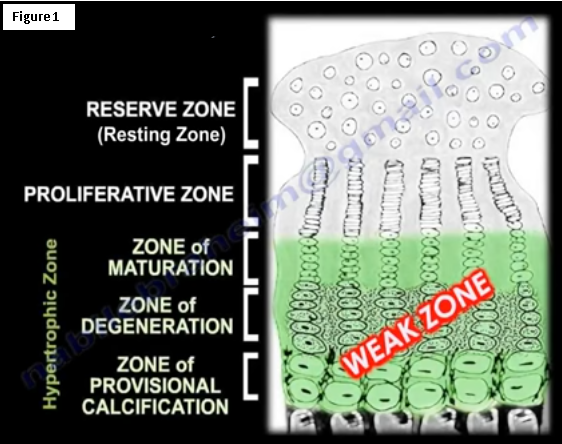
The physis is made up of several zones: the reserve zone (resting zone), proliferative zone, and the zone of hypertrophy (Figure 1). In the reserve zone, the cells store material such as lipids, glycogen, and proteoglycans and they have very low oxygen tension. In the proliferative zone, there is a high rate of activity and a high rate of oxygen tension. The zone of hypertrophy is the weakest zone and is comprised of three separate zones: the zones of maturation, degeneration, and provisional calcification.
In the zone of maturation, chondrocytes are enlarged (hypertrophic). In the zone of degeneration, chondrocytes increase in size and the matrix is prepared for calcification. In the zone of provisional calcification, chondrocytes degenerate and die. This allows the calcium to be released and the matrix to become calcified.
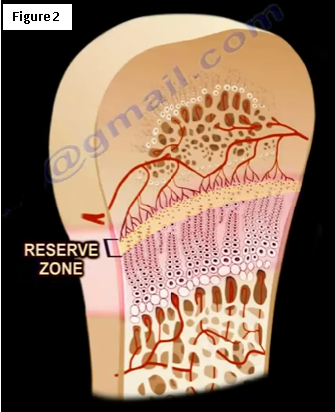
In the reserve zone (Figure 2), you can find the abnormalities known as Gaucher’s disease and Diastrophic dwarfism. Gaucher’s disease is an autosomal recessive deficiency in B-glucocerebrosidase. This disease occurs due to an enzyme deficiency that leads to the accumulation of sphingolipids in the organs, especially in the bone marrow, the liver, and in the spleen. Gaucher’s disease can cause problems with the avascular necrosis of the femoral head in children.
With diastrophic dwarfism, you will be able to see Hitchhiker thumbs and Cauliflower ear (Figure 3) due to the failure of sulfate transporter protein. Sulfate is important for the proteoglycans (chondroitin sulfate and keratin sulfate). So the proteoglycans are affected by under-sulfation, which is autosomal recessive because it is an enzyme problem.
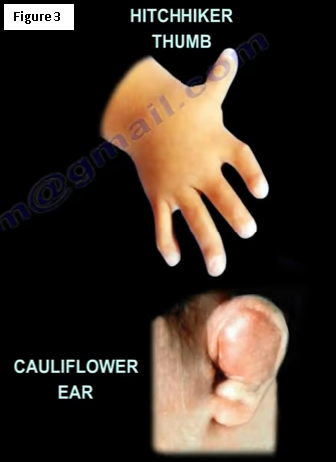
The proliferative zone determines whether a person is short or tall. In cases of shortness, such as with achondroplasia, the patient will have a disproportionate, short stature dwarfism (short limbs). This is caused by a mutation in the fibroblast growth factor receptor 3 (FGFR3). In this condition, the patient will have spinal stenosis and a “champagne glass” outlet of the pelvis. In cases where the patient is taller, such as gigantism—you will notice excessive growth and height, significantly above average.
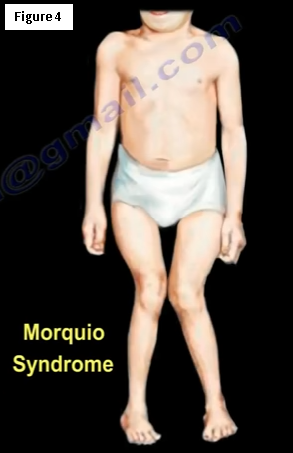
The hypertrophic zone is susceptible to several different problems which include: Rickets, Slipped Capital Femoral epiphysis (SCFE), fractures that involve the growth plate (Salter-Harris), and mucopolysaccharidosis. Salter-Harris fractures usually occur in the zone of provisional calcification. In cases of mucopolysaccharidosis, the patient will have proportionate dwarfism. This occurs due to the inability to metabolize one of the proteoglycans. Morquio Syndrome (Figure 4) is a disease caused by mucopolysaccharidosis and occurs due to an accumulation of Keratan sulfate. Patients with this disease may have odontoid hypoplasia and you will need to check the C1-C2 instability.
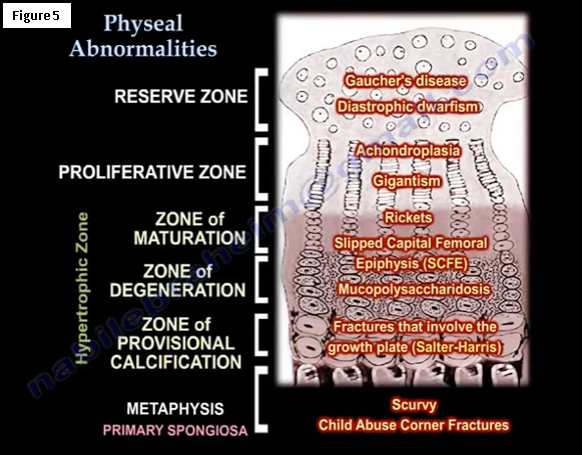
Scurvy and corner fractures in child abuse occur in the primary spongiosa (Figure 5) which is a part of the metaphysis below the hypertrophic zone (specifically the zone of provisional calcification). The primary spongiosa is created by the osteoblasts. When the primary spongiosa remodels, it then becomes a secondary spongiosa. Scurvy occurs due to a vitamin C deficiency, which then leads to a decrease in chondroitin sulfate and a decrease in collagen. Scurvy affects the hydroxylation of collagen peptides.
